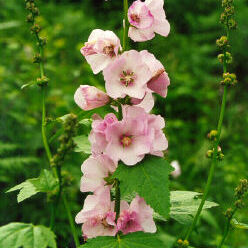Subshrubs or perennial herbs, often woody at base, glabrate to densely pubescent, hairs variously stellate to simple. Stems solitary to many, erect or ascending, rarely decumbent. distinct. Flowers: calyx somewhat accrescent or not, not inflated, lobes not strongly ribbed, lanceolate to ovate or ovate-triangular; corolla campanulate to subrotate, whitish or pinkish to rose-purple, exceeding calyx; staminal column ± included; filaments terminal and subterminal; ovary (6–)10–15( or 16)-carpellate; ovules 2 or 3(or 4) per carpel; styles (6–)10–15(or 16)-branched, (branches equal in number to carpels); stigmas terminal, obliquely capitate. Fruits schizocarps, erect, not inflated, subglobose, apically retuse, moderately indurate; mericarps (6–)10–15(or 16), drying black, 1-celled, oblong in lateral view, rounded at apex, thin-walled, smooth laterally, without dorsal spur, densely pubescent dorsally and apically with coarse, hirsute, velutinous simple hairs overlaying stellate hairs, sides smooth, glabrous, dehiscence loculicidal except ventral-basally where joined to columella by vascular bundles. Seeds 2 or 3(or 4) per mericarp, reniform to obovate-reniform, glabrate or puberulent marginally with simple, white to tawny hairs 1–2 mm. x = 33.
More
Bractlets of the epicalyx 3, narrowly linear, persistent; pet large; stamen-column bearing anthers at the summit; carpels numerous, 2–4-seeded, at maturity rounded at the summit, dehiscent to the base, thin-walled and plane on the sides, densely hirsute on the back with long, erect, simple hairs; branching perennial herbs with large, thin, palmately lobed, maple-like lvs and handsome fls solitary or fascicled in the upper axils. 7, U.S.

